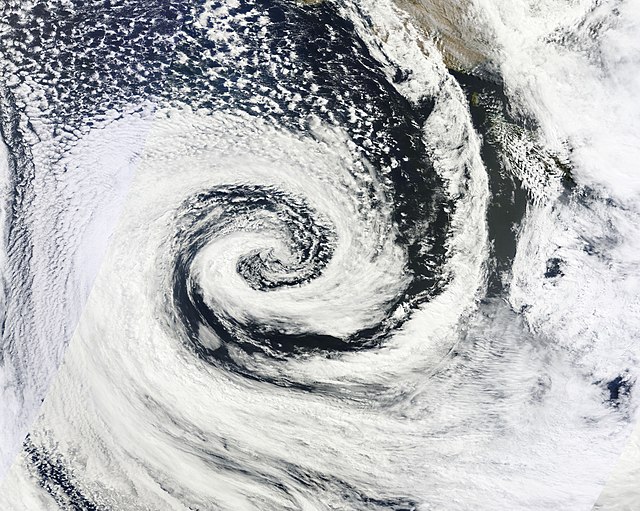Extratropical cyclones, sometimes called mid-latitude cyclones or wave cyclones, are low-pressure areas which, along with the anticyclones of high-pressure areas, drive the weather over much of the Earth. Extratropical cyclones are capable of producing anything from cloudiness and mild showers to severe gales, thunderstorms, blizzards, and tornadoes. These types of cyclones are defined as large scale (synoptic) low pressure weather systems that occur in the middle latitudes of the Earth. In contrast with tropical cyclones, extratropical cyclones produce rapid changes in temperature and dew point along broad lines, called weather fronts, about the center of the cyclone.
A powerful extratropical cyclone over the North Atlantic Ocean in March 2022
Approximate areas of extratropical cyclone formation worldwide
Hurricane Cristobal (2014) in the north Atlantic after completing its transition to an extratropical cyclone from a hurricane
QuikSCAT image of typical extratropical cyclones over the ocean. Note the maximum winds are on the outside of the occlusion.
In meteorology, a low-pressure area, low area or low is a region where the atmospheric pressure is lower than that of surrounding locations. Low-pressure areas are commonly associated with inclement weather, while high-pressure areas are associated with lighter winds and clear skies. Winds circle anti-clockwise around lows in the northern hemisphere, and clockwise in the southern hemisphere, due to opposing Coriolis forces. Low-pressure systems form under areas of wind divergence that occur in the upper levels of the atmosphere (aloft). The formation process of a low-pressure area is known as cyclogenesis. In meteorology, atmospheric divergence aloft occurs in two kinds of places:The first is in the area on the east side of upper troughs, which form half of a Rossby wave within the Westerlies.
A second is an area where wind divergence aloft occurs ahead of embedded shortwave troughs, which are of smaller wavelength.

A clockwise spinning low-pressure area or cyclone of southern Australia. The center of the spiral-shaped cloud system is also center of the low.
A low-pressure system over Iceland.
This depiction of the Hadley cell shows the process which sustains low-pressure areas. Diverging winds aloft allow for lower pressure and convergence at the Earth's surface, which leads to upward motion.
QuikSCAT image of typical extratropical cyclones over the ocean. Note the maximum winds on the poleward side of the occluded front.







